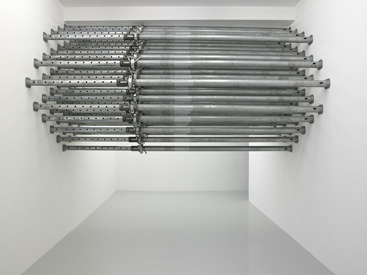
Born in 1971 in Gdansk (PL)
Lives and works in Gdansk (PL)

2003
Scaffolding props
Dimensions variables
Year of Purchase: 2003
The gallery space is vacant. Its idleness is challenged by artistic and curatorial endeavours and by the very presence of those who enter. However, the semiotics of the gallery space are emotionally and intellectually complicated and there is no innocent coupling with it. One Ton in the Air (2003) by Dominika Skutnik works both within the space and over the body of those who decide to get in. It first astonishes by squeezing a huge amount of metal construction between the walls of a relatively small space. It is one of those things that should not be there, looking awkward and inappropriate. The way the work presses up against the gallery wall builds up real tension within the venue. The walls of the white cube appear to be about to crack, forced to bear the unusual weight of stretching scaffolding. But it also works in emotional terms as a passive aggression within the frame of relations between those who make, produce, present and absorb art. The one who goes to the gallery space is no longer the viewer or the spectator here, but turns out to be a participant in a spatial relation, a power structure, a physical domination and a psychological game. In the case of a work by Dominika Skutnik, it is an experience at your own risk, although the danger might happen only in your imagination.
Several works by Skutnik, such as Field(2003), Wreath (2003) or Tattoo (2005), use the invisible, and in two cases also silent, presence of an electromagnetic field. You are supposed to put your head and sometimes your entire body inside the generating structure – turned into a spatial drawing or sculptural form. Its possible operation is not visible. We cannot even sense it. But we acknowledge that it might have some impact on our body, our health or thinking. But at the same time, the knowledge of the actual presence of this field comes from the artist, and we have to trust her that the thing is really there. This creates an ambiguity of trust and distrust, fear and courage.
Headhunter (2004), a heavy and very sharp mezzaluna knife once hung above stairs to a basement, created a tension between the architecture needed to explore the guarded area and an experience of real danger that the blade potentially represented. One Ton in the Air is visibly heavy, but once again the real weight is unknown. Skutnik forces the inquisitive participant to pass to the other side of the room underneath the suspended structure, to see what is on the other side. Her tactics are both formed by the psychology of perception and strongly aware – almost ironic – when commenting upon the spatial conditions in which art is being presented. Her installations reveal a kind of uncanny performativity of space and leave the viewer feeling uncertain as to his position in it. Its subject extends from the fear of the gallery space, the participatory aspect in aesthetic experience to the hidden emotions they create.
Aneta Szylak